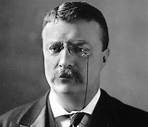
LOUISIANA, Mo — Following is the final in a two-part story series by contributing writer Brent Engel.
Unlike presidential appearances in the 21st century, there were no protestors to disrupt or disrespect Theodore Roosevelt when he visited Louisiana in 1903.
“The good order which prevailed throughout the day was another feature of which we feel proud,” the Pike County News wrote. “Not a disturbance occurred and not an accident happened to mar the harmony and pleasure of the occasion and not a partial of partisan feeling was exhibited. The people recognized the president as their chief servant and honored him therefor.”
A crowd estimated at 7,000 to 10,000 people was “anxious to get up close so that they could hear and see,” added the Louisiana Press. It was “certainly an honor and credit to all concerned that the event passed off as nicely and satisfactory as it did.”
Roosevelt’s speech, which lasted eight minutes, was well-received, but newspapers noted one slight bit of disappointment. Teddy apparently didn’t get his shoes dirty.
“It cannot be said that the president touched the soil of Old Pike for he walked upon an elegant Brussels carpet which (local business) Wald Bros. furnished for the occasion,” The Press said.
Roosevelt acted as if he didn’t want to leave, because handlers had to tell him it was time to get on his train on go to St. Louis. The president told Louisiana Business Association representative Bert S. Carrick that he appreciated the “hearty good will shown him by our people,” the Press added.
“Good bye and good luck,” Roosevelt said as the train lurched south from the station.
Others accompanying the President in addition to Democrat Congressman Champ Clark of Bowling Green and Carrick included former Pike County Republican Congressman and U.S. Attorney David Patterson Dyer, who would be appointed a federal judge by Roosevelt in 1907; former Louisiana city attorney, Pike County prosecutor and Missouri State Senator David A. Ball, a law partner of Clark’s who would run unsuccessfully for governor in 1908; and attorney, bank president and La Crosse Lumber Company executive Charles G. Buffum.
The party also included Roosevelt’s Secretary of the Treasury, Leslie Shaw, a former Iowa governor; Surgeon General Presley Rixey; and Presidential Secretary William Loeb Jr.
Newspapers noted that the train included a library, smoking rooms, an observation area, private office and barber in addition to a dining area, sleeping quarters and restrooms.
“Every convenience of the executive mansion is at his hand,” the Press reported.
The reception committee included Louisiana Mayor John Cole and 90 other residents, along with dozens of people from other Pike County communities. There were also committees on decorations, grounds and platform, music, advertising and guard of honor.
In a letter to Carrick the next day, Dyer thanked “the people of Pike County for the splendid reception accorded the President” and offered appreciation to the reception volunteers.
“Your appointments were splendidly arranged and executed, and the members of your several committees performed their duties with great care and dignity,” Dyer said.
Roosevelt was “greatly pleased (and so expressed himself on the train) with the splendid reception accorded him at Louisiana,” Dyer continued. “The hospitality for which Pike County is noted was never better illustrated than it was yesterday. The loyalty of all our people to the government and their respect for the President without regard to party, is the surest guarantee of the perpetuity of our free institutions.”
Dyer finished by asking God to bless America and “save it for our children and their descendants to the remotest generation.”